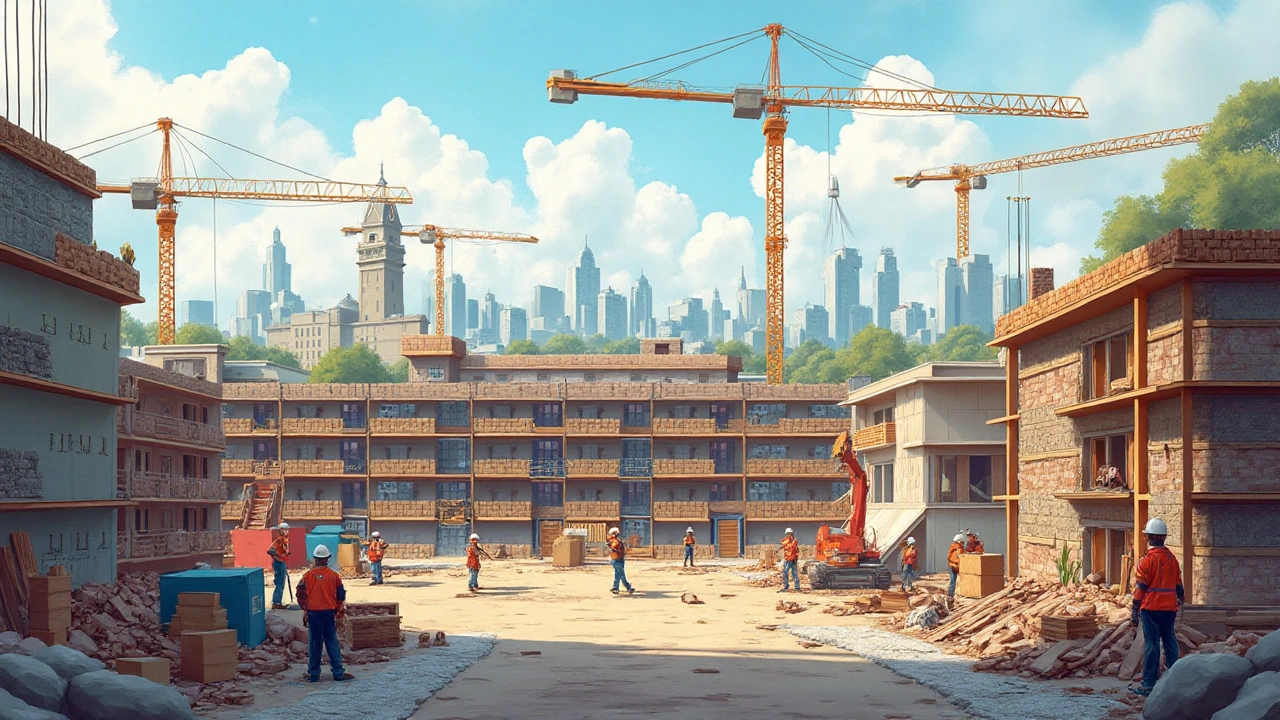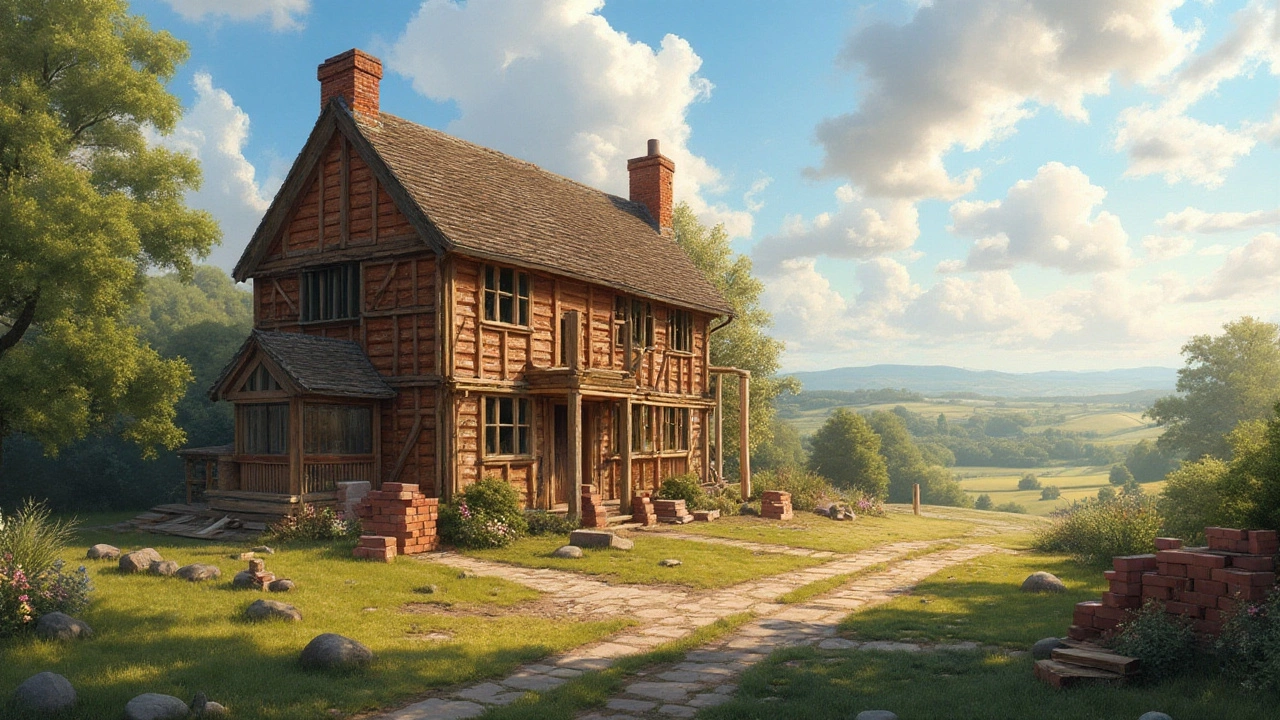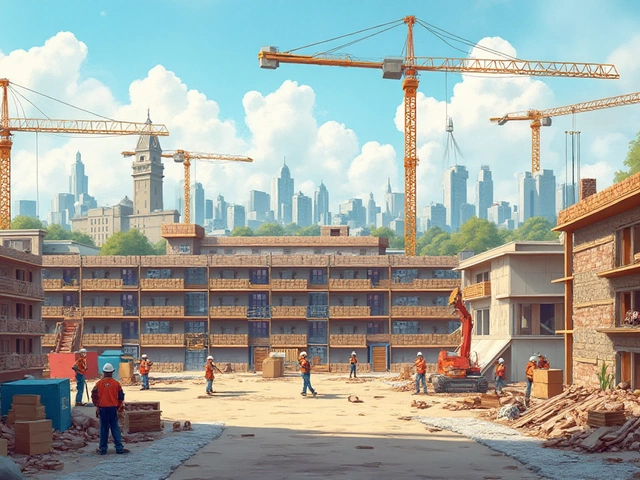Understanding Essential Raw Materials in Construction

Constructing the world around us relies heavily on essential raw materials that form the backbone of every building project. While the construction industry continually evolves with new technologies, the demand for reliable, natural materials remains constant. In this article, we'll delve into five primary raw materials that are pivotal to the construction sector, examining their unique properties, benefits, and roles in shaping urban and rural landscapes alike.
Drawing from both traditional and contemporary building practices, these materials not only offer structural integrity but also embody a blend of aesthetic appeal and sustainable qualities. Whether you're an architect, builder, or enthusiast, understanding these materials provides a deeper appreciation of how our environments are crafted. Let's embark on a journey to explore the remarkable contributions of concrete, wood, steel, bricks, and glass in the world of construction.
- Concrete and Its Components
- The Versatility of Wood
- Steel: Backbone of Modern Architecture
- The Role of Bricks and Masonry
- Innovations in Glass Use
Concrete and Its Components
Concrete stands as an indispensable pillar in the field of construction, being the most widely used building material globally. Its application ranges from towering skyscrapers to intricate pavements, serving as a testament to its versatility and enduring strength. At its core, concrete is a simple mixture of four primary elements: cement, water, sand, and aggregates. Each component plays a critical role, working in harmony to achieve a material that is both durable and adaptable.
The process begins with cement, the binding agent that holds the mixture together. The most common type used is Portland cement, which originates from a blend of limestone and clay. When mixed with water, cement undergoes a chemical reaction known as hydration, transforming the mix into a hard substance capable of withstanding significant stress. The amount of water used is crucial, as too much can weaken the final product, while too little could prevent thorough mixing.
Sand, along with other fine aggregates, is introduced to fill voids between the larger aggregates like gravel or crushed stone. These elements contribute to creating a concrete that is strong and dense, essential for supporting immense weights and resisting different environmental pressures. A well-composed concrete mix strikes the perfect balance, ensuring longevity and minimal maintenance.
The Role of Admixtures
Admixtures are specialized ingredients added to modify the properties of concrete. Whether it's to enhance workability, accelerate curing, or improve resistance to extreme weather conditions, these additives offer an extra layer of customization. In recent years, sustainable options such as fly ash or silica fume have become popular choices, reducing environmental impact while enhancing strength and durability."Concrete is the real economy," remarked Graeme Maxton, emphasizing its critical role in infrastructure and economic development worldwide. His statement underlines the significance of concrete not just as a building material, but as a cornerstone of societal progress.
| Component | Property |
|---|---|
| Cement | Binding strength |
| Water | Workability |
| Sand | Density |
| Aggregates | Durability |
Properly selected and proportioned, these components of concrete offer a vast spectrum of possibilities in architectural design and engineering feats. Whether you're building a family home or planning a complex infrastructure project, understanding the intricacies of concrete composition can lead to more informed choices, ensuring the stability and resilience of the structures we rely on daily.
The Versatility of Wood
Wood, a timeless building material, has been integral to construction for centuries. Its versatility and natural beauty make it a favorite for architects and builders alike. From framing homes to crafting elegant interiors, the applications of wood are vast and varied. One of the main reasons wood is so valued in the construction industry is due to its ability to be tailored to different needs. It can be cut, shaped, and joined in almost endless configurations, making it an ideal fit for creative designs and practical applications.
The choice of wood species plays a significant role in its construction use, influencing factors like durability, strength, and appearance. Softwoods, such as pine and cedar, are often used for structural purposes like beams and frames because they are light yet robust. Hardwoods, including oak and mahogany, are popular for furnishing and flooring due to their strength and stunning grain patterns. Interestingly, the sustainability of wood is a key point in modern construction. Sustainably sourced wood, such as those certified by the Forest Stewardship Council (FSC), ensures a reduced environmental impact, aligning with eco-friendly building practices.
Construction materials like wood also offer excellent thermal properties, providing natural insulation that can enhance energy efficiency in homes and buildings. Wood's cellular structure contains pockets of air, which helps regulate indoor temperatures and reduces reliance on artificial heating and cooling systems. This quality makes it a favored material in regions with varied climates, offering comfort throughout the year. A report by the Wood Products Council highlights that wooden buildings can vastly lower CO2 emissions compared to those made from other primary materials.
"Wood is the most renewable, recyclable, and biodegradable of construction materials, offering environmental advantages that others cannot." - Wood Products Council
Aside from structural purposes, wood's aesthetic appeal cannot be overstated. Its warmth and natural grain lend a cozy, inviting atmosphere that is difficult to replicate with synthetic materials. This charm is why wood remains a popular choice for cladding, decking, and interior panels. Its ability to seamlessly blend with other materials also adds to its appeal. For instance, pairing wood with glass or metal can create a modern, sophisticated look that is both unique and timeless.
The innovations in wood treatment and engineering have expanded its use even further. Engineered wood products, such as glulam and cross-laminated timber (CLT), provide enhanced strength and stability, opening new possibilities in large-scale construction. These advancements have positioned wood as a competitive alternative to traditional steel and concrete, paving the way for timber skyscrapers and other ambitious architectural projects. With its blend of tradition and innovation, wood continues to be an invaluable resource in the search for sustainable and creative building materials.

Steel: Backbone of Modern Architecture
In the realm of modern architecture, steel has emerged as a cornerstone material, integral to transforming our skylines and defining the characteristic features of today's urban landscapes. Its unmatched strength-to-weight ratio makes it an ideal choice for skyscrapers, bridges, and expansive industrial structures. The versatility of steel allows it to be molded, welded, and adapted into almost any shape conceivable by architects and engineers. This incredible adaptability, paired with its durability and ability to withstand significant stress and force, ensures that steel remains the backbone of structural development in contemporary construction.
Historically, steel's advent in construction is often credited to the late 19th and early 20th centuries, marking a revolutionary shift from traditional building materials like iron. Its superior tensile strength and resilience against fatigue have provided architects with new possibilities, quite literally allowing their imaginations to reach new heights. The iconic Eiffel Tower is a testament to steel's aesthetic potential and structural capabilities, a landmark that initially faced skepticism but now stands as a tribute to human ingenuity and engineering prowess. In modern design, steel facilitates the construction of open spaces, providing the framework that supports glass facades and expansive atriums, thus enabling the creation of both functional and visually striking structures.
"The strength of steel is in its ability to unify elegance with endurance — a metal poem of architectural resilience," remarked famous American architect Frank Lloyd Wright.
Steel's benefits are not solely limited to its strength and flexibility. It is also highly sustainable, often containing a significant percentage of recycled content, and it can be recycled repeatedly without losing quality. This sustainability factor is increasingly important in the context of environmental awareness and the push towards more eco-friendly construction practices. Cold-formed steel components are frequently used in residential and commercial buildings alike, reducing both material wastage and the carbon footprint of building processes. This balance between ensuring robust infrastructural growth and maintaining environmental stewardship underscores steel's vital role in the future of the construction industry.
Innovations and Future Prospects
Recent developments in steel production and treatment technology have introduced advanced steel grades, such as weathering and tempered steels. These innovations provide even greater durability and resistance to the harsh elements, expanding the potential of steel in regions with challenging climates. With smart building trends on the rise, steel's integration into connected infrastructure and buildings is also gaining traction, wherein steel's conductivity supports the embedding of smart technologies. Such advancements illustrate steel's enduring adaptability and assure its central position in upcoming architectural projects, both in terms of scope and scale.
The inherent qualities of steel, combined with the continuous innovations in its application and treatment, consolidate its status as an irreplaceable asset in modern architecture. By marrying technology with tradition, steel continues to provide the backbone for new paradigms in design and construction, ushering an age where towering superstructures and sustainable living spaces stand side-by-side harmoniously, made possible by this remarkable material.
The Role of Bricks and Masonry
Bricks and masonry have been the stalwarts of construction since the dawn of civilization, prevalent in iconic structures from the Great Wall of China to the Roman architecture that dots Europe. For countless generations, these robust materials have stood the test of time, offering a unique combination of strength, durability, and aesthetics. Bricks, made primarily from clay and shale, are fired in kilns at high temperatures to achieve their signature hardness. This firing process fuses tiny particles together, creating a robust material capable of withstanding loads and weather fluctuations, which is crucial for building materials.
One of the most significant advantages of bricks and masonry is their fire resistance, a vital safety feature in any construction project. These materials don't just resist fire—they help to contain it, providing critical time for evacuation and reducing potential damages. Another aspect revered by architects and builders alike is their thermal mass properties. In layman's terms, bricks and masonry absorb heat during the day and slowly release it during the night, helping to maintain more consistent interior temperatures, which can lead to energy savings. This not only contributes to a more comfortable living environment but also aligns with modern sustainability goals.
In the realm of masonry, mortar—used to bind the bricks—is just as essential. Composed of a mix of cement, lime, and sand, mortar serves as the glue that holds everything together. When used correctly, it creates a watertight seal, critical in preventing moisture ingress, which could lead to structural damage over time. The precision with which bricks are laid influences not only the structural integrity but also the aesthetics of a building. Patterns such as Flemish or English bonds are not just for visual appeal; they distribute weight evenly across the structure, further enhancing stability.
Reflecting on recent communal thoughts, famed architect Louis Kahn once said,
"Even a brick wants to be something, it aspires. Even a common, ordinary brick...wants to be something more than it is."This sentiment captures the essence of why these construction materials remain invaluable. They are more than mere elements—they're fundamental to creating spaces that inspire. Innovations continually emerge, such as the development of eco-friendly bricks made from recycled materials. This evolution is vital in today’s climate-conscious era, where every effort counts towards preserving our environment.
To appreciate the global significance of bricks, consider this remarkable stat: annually, over 1.23 trillion bricks are produced worldwide. This staggering figure reflects not just their popularity but their necessity. Builders favor bricks for their versatility and the distinct sense of permanence they impart to a structure. Whether it's a small residential property or a towering skyscraper, bricks and masonry go beyond their basic function—they help shape stories and foster a sense of belonging. For those engaged in construction, selecting the ideal raw materials is a nuanced process, impacted by considerations like climate, intended use of the building, and cultural preferences.

Innovations in Glass Use
In the realm of construction materials, glass has emerged as a versatile champion, primarily due to its aesthetic charm and functional benefits. The modern interpretation of glass goes far beyond traditional windows, encompassing a world of possibilities driven by technological advancements. One of the most exciting developments is smart glass, known for its ability to alter transparency in response to external influences such as temperature, light intensity, or electric current. This feature not only transforms the space's visual ambiance but also enhances energy efficiency by reducing reliance on artificial lighting and heating systems.
Sustainable architecture often embraces glass innovations as they align with the shift towards eco-friendly buildings. For instance, photovoltaic glass panels integrate solar cells, allowing windows to harness and convert solar energy into electricity. This increases the potential for buildings to become self-sufficient in energy requirements, significantly lowering carbon footprints.
"Incorporating photovoltaic materials in architecture shifts the narrative of buildings from being energy consumers to potential energy producers," suggests Dr. Elena Diaz, a leading sustainability advocate.Engineers have also developed advanced insulating glass units, providing superior thermal insulation and noise reduction, contributing to comfortable indoor environments. These advances make it possible to design structures with an emphasis on tranquility and energy conservation without compromising on aesthetics.
On top of these innovations, the use of laminated glass has seen a rise, primarily due to its strength and safety features. Laminated glass consists of two or more glass layers bonded with a plastic interlayer, making it challenging to break. When it does break, the shards adhere to the plastic layer, minimizing injury risks. Beyond safety, laminated glass also offers UV protection, a critical feature in safeguarding interior furnishings from sun damage. Another fascinating application is the use of acid-etched or frosted glass for privacy-focused applications, adding an elegant touch while maintaining a sense of openness.
The most striking transformation might be seen in how glass is implemented in facades and skylights. Architects often opt for structural glazing systems that not only enhance visual appeal but improve building performance. These systems seamlessly integrate with other building materials, creating expansive, uninterrupted surfaces that bathe interiors with natural light.
Benefits of Glass Innovations
- Energy Efficiency
- Sustainability
- Enhanced Safety
- Natural Lighting
- Design Flexibility


